

Page 31. End of Empire
Page 31c. France and her Colonies
 |
|||||
Page 31. End of Empire Page 31c. France and her Colonies |
|||||
|
|
||||||||||||||
|
Continued from previous page, 31b.
The three provinces of French Indo-China British
Major General Douglas Gracey, in command of the Allied Control Commission in Indo-China, hands over to French General Leclerc,
commander of French Forces in the Far East, with the presentation of a sword surrendered by the Japanese to the British in
Burma.
The Ho Chi Minh Trail
https://www.youtube.com/watch?v=sNL_Hern8XU&feature=relmfu
or, the same:
Episode from the US Army’s TV documentary
series Big Picture about US Army Special Forces training of Mon-Khmer and Malayo-Polynesian tribes in the central highlands
of
https://www.youtube.com/watch?v=5N8sBrWPNWk
In the U. S. army, a battalion at full strength usually has at 600 to 800 men. A battalion is commanded by a lieutenant-colonel. Generally, the battalion commander is in
the field with his trooops. With the battalion's small command unit there
is also the battalion's sergeant-major. With the batallion's command unit or headquarters, is a medical unit . . . Initially, one battalion, the First
Battlation, was engaged in the Battle
of LZ X-Ray. It had 450 men. The officer in command was Lieutenant Colonel Harold ("Hal") Moore. The sergeant-major was
Basil Plumley. A battalion usually
consists of four companies - Company A or Alpha Company, Company B or Bravo Company, Company C or Charlie Company, and Company D or Delta Company. Af
full strength, a company usually
has 150 men. Often, a company is much smaller. A company is commanded by a captain. A company usually consists of four platoons - First Platoon, Second Platoon, Third
Platoon and Fourth Platoon. A platoon is led by a lieutenant. There is a small command unit with the company's captain. Platoons are usually divided into four squads, each commanded by a sergeant.
There are usually
three to four fire teams in a squad. The fire team is led by a corporal. There
are usually four battalions in a brigade or regiment, which is commanded by
a full colonel or a brigadier general. The brigade commander is generally not in the field or engaged directly in front
line combat. Lt.-Col. Moore's battalion, the 1st Battalion,
was with the 7th Cavalry Regiment. This regiment was formed in 1866. It was
posted to the west to protect settlers against Indians. The 7th Cavalry Regiment was the regiment of a
battalion commanded by the legendary Lieutenant Colonel George Armstrong Custer.
Custer Custer and his battalion were wiped out at
the Battle of Little Bighorn (Custer's Last Stand) by Indians led by
Chief Sitting Bull and Crazy Horse in 1876. The 7th Cavalry
Regiment was made up of many Irish immigrants. Thus, its marching tune was Gerry Owen. https://www.youtube.com/watch?v=4m7RPjQxjmA and https://www.youtube.com/watch?v=gaPk9yYWQcM The cavalry was
mechanized after WWI (1914 - 1918) and motor vehicles replaced horses. In the Korean War (1950 - 1953), the cavalry rode
to combat in helicopters for the first time. There are usually four
brigades or regiments in a division. A division is commanded by a major-general. The 7th Cavalry
Regiment is with the 1st Cavalry Division, which was formed in 1921. First Cavalry Division (Airmobile) in Vietnam Episode from the U. S. Army documentary series
The Big Picture https://www.youtube.com/watch?v=kCwNlrt27-Y I am a Soldier Episode from the ABC TV 1965 documentary series The Saga of Western Man This
documentary follows Company A of the 1st Battalion of the of 8th Cavalry Regiment of the 1st Cavalry Division in the field
in Vietnam in late 1965. https://www.youtube.com/watch?v=TawIUttZb7g An Khe Vietnam Documentary describes the routine of the 1st Cavalry Division (Airmobile) at its base in An Khe on December
9 - 11, 1965 https://www.youtube.com/watch?v=lY6kTKW-BZ8 Toward the
end of the first day of the Battle of LZ X-Ray, November 14, Moore's
battalion was joined by elements of a another batallion, the 2nd Battalion, also from the 7th Cavalry Regiment. The fighting on Chu Pong around LZ X-Ray continued
into the next day, November 15. The rest of 2nd Battalion of the 7th Cavalry Regiment and the 2nd Battalion
of the 5th Cavalry Regiment arrived. Fightig contiued
into the next day, November 16. Lt.-Col. Moore's
battalion was withdrawn and airlifted by helicopter back to base on November 16. The two other battalions
pulled out of LZ X-Ray on the next day, November 17, to get out of the way of B-52 carpet bombing of the area. B-52s bombed the hill and area about the abandoned
LZ X-Ray. The 2nd Battalion of the 5th Cavalry Regiment
marched to LZ Columbus. The 2nd Battalion of the 7th Cavalry Regiment
marched to LZ Albany. Half of the 2nd/7th
was wiped out in an ambush by the PAVN/NVA along the trail to LZ Albany. Fighting contunued throughout the night. The PAVN/NVA
withdrew on the morning of November 18. LZ Columbus fought
off several attacks during the night of November 18. The PAVN/NVA withdrew at midnight. There are usually four divisions in a corps, which is commanded by a lieutenant-general. There are
four corps in an army, which is commanded by a general. The supreme American
military commander in Vietnam from 1964 to 1968 was General William Westmoreland. His position was Commander, Military Assistance Command, Vietnam (MAC-V). He wore four stars. General
- commands an army (wears four stars) BBC-TV 1998 https://www.youtube.com/watch?v=6WpCV9_a170
Soldiers of the three platoons of C Company - First, Second and Third (the latter with
the company's
Command
Unit) - were landed by helicopters west of the hamlet of My Lai (# 4). Helicopter pilots
warned that they would be landing under fire. Once on the ground, the soldiers fired
into the hamlet. This was Standard Operating Procedure (SOP). Aerial
view from the northeast of the hamlet of Tu Cung (My Lai 4). At the bottom of the photo is the sub-hamlet of Binh Tay. First and Second platoons proceeded eastward into the hamlet. Only elderly men, women and children were encountered in the hamlet.
Second Platoon swept through the north of My Lai (# 4) to its
eastern end, shooting any people encountered along the way. This was Standard Operating Procedure
(SOP). First Platoon swept eastward through the center
of My Lai (# 4), destroying the hamlet and shooting inhabitants. First
and Second platoons met at the eastern end of the hamlet. Second
Platoon then swept westward back through the
hamlet, shooting inhabitants on the way.
Third Platoon,
with the command unit, approached My Lai (# 4) from the south. On the way, the platoon encountered a large group of villagers
leaving the village on the road and killed them. Third Platoon
entered My Lai (# 4) and joined First and Second Platoons in killing more inhabitants throughout the village, including a
large number herded into an irrigation ditch. After an hour or so,
First Platoon moved eastward out of My Lai (# 4).
Second
Platoon moved into a sub-hamlet to the north, Binh Tay,
destroyed it and killed more than a dozen inhabitants.
B Co. was standing by, in position, near the hamlet of My Khe (# 4), two to three kilometers to the east, by the sea. C Co. informed B Co. that the enemy had not been encountered. Second Platoon, B Company then proceeded northward toward the hamlet of My
Lai (# 1) - "Pinkville" - where the VC battalion headquarters, the main objective
of the operation, was believed to be. Second Platoon abandoned the objective - "Pinkville"
- after losing three men to mines along the way, including the second
lieutenant who led the platoon. Second
Platoon and Third Platoon of B Company then met at a point to the north and west of "Pinkville".
Perhaps a dozen actual VC were killed in Son My that day. It
was estimated that between 150 and 300 inhabitants were killed in Son My by the early afternoon. The final count was
504. Some American
soldiers refused to kill women, children and the elderly. Six-and-one-half hours into the operation, the foot soldiers received the order, relayed from
the lieutenant-colonel commanding the operation from a helicopter hovering above the area, to stop the killing. (It was not
the first such order but the killing ended at that point.) Some
soldiers wondered why the killing had to stop. The
operation resumed the next day, March 17. C Company went to the hamlets
of My Khe (# 1) and My Khe (# 3) and reportedly killed two VC. A and B companies . . .
After the Operation The VC battalion, which was supposed
to be in Son My, had been greatly reduced during the Tet Offensive the month before, in February. Only a small number remained
in Son My. It was later reported that the VC battalion was actually in the mountains far to the west of Son My and trying
to regroup at the time. A
few American soldiers complained to their senior officers (and some later to congressmen) about the killing of women, children
and elderly people by other soldiers. Two to three months after the massacre,
the lieutenant-colonel who commanded the operation in Son My and the captain in command of Bravo Company were killed in a
helicopter accident. The
leader of Charlie Company's
second platoon, which
partook in the killing in My Lai (# 4), did all the killing in the sub-hamlet of Binh Tay, and was the platoon involved in
the bunker incident reportedly
committed suicide some time later. Eventually, word about a massacre
of Vietnamese villagers got out and there was an inquiry by the army. Was
the killing of many inhabitants an unavoidable part of an operation to clear an area and to be expected? Or
was the killing of inhabitants commmitted by soldiers gone bezerk? Army
investigators concluded that the massacre of the inhabitants of Son My was well-thought out in advance, carefully planned,
organized and deliberate. The army investigators recommended
criminal charges against several junior officers for their conduct in the field. The
investigators also recommended criminal charges against senior officers who planned and commanded the operation from
remote locations for not reporting the massacre and for covering it up. The
army investigation and inquiry and the army courts-martial were deliberatly limited and intended largely for show. Many soldiers were never questioned by army investigators or summoned to testify before the courts-martial.
One army officer, for instance, who was assigned to a desk job in the area of the massacre, ignored (glossed over)
a report of the massacre that was passed on to him. He could have been ruined if questioned. He went on to become chairman
of the joint chiefs of staff and US secretary of state. For decades - and
to this day - some have touted him as a possible candidate for US president. He was one of several soldiers passed up by investigators without explanation. Army investigators tried to hide B (Bravo) Company's massacre of villagers in My Khe (# 4) from the press.
The
government bribed and coerced the press to ignore the extent of the massacre and involvment of American soldiers. One competent and hard-driving junior field officer, the second lieutenant who led Charlie Company's
first platoon, was set up by the army as the fall-guy and scapegoat for condemnation in the press long before the army investigation
and army courts-martial. Of 26 soliders charged by the courts-martial
only one soldier - the
leader of Charlie Company's first platoon, one of the three platoons involved in the killing at My Lai (# 4)
- was convicted. He was sentenced to life in prison. The
captain in command of Charlie Company was tried and acquitted of all charges. The second lieutenant who led Charlie Company's third platoon (with the company's
command unit), which
killed the villagers on the road and partook in the killing in My Lai (# 4), was not charged. The
second lieutenant who led Bravo Company's first platoon, which committed the massacre in My Khe (# 4), was charged but
not tried. Following a huge outcry of indignation
from the American public that the lone convicted soldier had been following orders and perfoming his duty, the American president
ordered his release and he was parolled after three years of house arrest on an army base. The division commander, a major-general,
at the time of the massacre, went on to become the superintendent of the U. S. Military Academy at West Point. But
for covering up the massacre, he was denied promotion and demoted, stripped of his Distinguished
Service Medal and compelled to leave the academy.
-------------------- There
were many massacres of village inhabitants in Vietnam. Massacres by American, South Korean, North Vietnamese and South Vietnamese
soldiers are known. But most of the massacres were never made public. Note:
In the US army a company often consists of 150 men at full strength and is commanded by a captain. A company is usually divided
into four platoons - First, Second, Third and Fourth - each led by a
lieutenant. There is also a unit or platoon with the company commander. The platoons are usually divided into four squads,
each commanded by a sergeant. There
are usually four companies
- A (Alpha), B (Bravo), C (Charlie) and D (Delta) - in a battalion, which is commanded by a lieutenant-colonel. There are usually
four battalions in a brigade, which is commanded by a full colonel. There are usually four brigades in a division, which
is commanded by a major-general. There are usually four divisions in a corps, which is commanded by a lieutenant-general.
There are four corps in an army, which is commanded by a general. There are
often exceptions to this rule. Battalions are sometimes identified as part of a regiment.
National Archives, Wash.,
D. C. National Archives, Suitland,
Maryland Harold Moore commanded a battalion at the Battle of Ia Drang in 1965. In his book,
We Are Soldiers Still, published 2005, Moore remarked that if the lieutenant-colonel commanding the task force in
the My Lai operation had been on the ground with his trooops instead of in a helicopter high above them, the massacre could have been prevented.
-----------
The graph above displays the level of American troops in South
Vietnam from the beginning of 1959 to the end of March 1973. Note the dramatic
increase in American troops in South Vietnam during the administration of Lyndon Johnson, from 23,300 in 1964 to 536,100 in 1968. Johnson ordered a halt to the aerial bombing of North Vietnam before
the American presidential election of November 1968. Johnson's halt remained in effect till Nixon's bombing campaigns
of 1972. The new president, Richard Nixon, began to decrease the level
of American troops in South Vietnam in mid-1969, not long after assuming office. Note the dramatic decrease by Nixon from half a million in early
1969 to 24,200 in 1972 and almost zero in
1973. Allied Troop Levels in Vietnam 1960 to 1973 | ||||||||||||||
| Year | U. S. A. | South VN | Australia |
South Korea |
New Zealand | Philippines | Thailand |
|---|---|---|---|---|---|---|---|
| 1959 | 760 | 243,000 | -- | -- | -- | -- | -- |
| 1960 | 900 | 243,000 | -- | -- | -- | -- | -- |
| 1961 | 3,205 | 243,000 | -- | -- | -- | -- | -- |
| 1962 | 11,300 | 243,000 | -- | -- | -- | -- | -- |
| 1963 | 16,300 | 243,000 | -- | -- | -- | -- | -- |
| 1964 | 23,300 | 514,000 | 198 | 200 | 30 | 20 | -- |
| 1965 | 184,300 | 642,500 | 1,560 | 20,620 | 120 | 70 | 20 |
| 1966 | 385,300 | 735,900 | 4,530 | 25,570 | 160 | 2,060 | 240 |
| 1967 | 485,600 | 798,700 | 6,820 | 47,830 | 530 | 2,020 | 2,200 |
| 1968 | 536,100 | 820,000 | 7,660 | 50,000 | 520 | 1,580 | 6,000 |
| 1969 | 475,200 | 897,000 | 7,670 | 48,870 | 550 | 190 | 11,570 |
| 1970 | 334,600 | 968,000 | 6,800 | 48,450 | 440 | 70 | 11,570 |
| 1971 | 156,800 | 1,046,250 | 2,000 | 45,700 | 100 | 50 | 6,000 |
| 1972 | 24,200 | 1,048,000 | 130 | 36,790 | 50 | 50 | 40 |
| 1973 | 50 | 1,110,000 | -- | -- | -- | -- | -- |
SOURCE: Dept of Defense Manpower Data Center
There were American military advisors in South Vietnam. In 1963, for instance, there were some 40,000 American military advisors. This is not included in the figures above.
By 1973, there remained only a small contingent of U. S. Marines in Saigon. There were American military advisors with the South Vietnamese army. .
The last American soldier left South Vietnam on March 29, 1973.
President Nixon
Address to the Nation about Vietnam (and domestic problems)
March 29, 1973
https://www.youtube.com/watch?v=I9X7HHrqABE
29th March 1973
Last US troops withdraw from Vietnam
History Pod
https://www.youtube.com/watch?v=W5vD9iJkPkc
--------------
John McCain, center, and other American
POWs, just released from the Hanoi Hilton,
head for
a C-41 plane that will take them to
the Philippines, March
14, 1973.
Film footage of the
release of POW John McCain
March 1973
Washington, D. C., May 24, 1973
---------------------
Timeline
----------------------
The
"Decent Interval"
"Decent interval" refers to the two-year period from the Paris Peace
Agreement in January 1973 to the North Vietnamese invasion of South Vietnam in late 1974 and early 1975.
Vietnam
Still America's War
A Report by John PIlger (1974)
Australian TV
--------------------
Xuan Loc
British news report
12 April 1975
https://www.youtube.com/watch?v=Fe919aTTVuY
South Vietnam 18th Infantry Division
Last stand against North Vietnamese
Battle of Xuan Loc
12 days
Lecture by James Willbanks
Dole Institute of Politics
2017
https://www.youtube.com/watch?v=m5QSMIKGQlg
--------------------
The End of South Vietnam
1975
North Vietnamese invasion, January - April 1975

---------------------------
------------------------
 Nguyen Cao Ky on TV in U. S. in 1975
Twenty Years
and Twenty Days
Nguyen Cao Ky
Interview with William F. Buckley Jr. on Firing Line
1975
Entire interview (59:26)
Nguyen Cao Ky
Interview (1981) (01:01:55)
Nguyen Cao Ky on TV in U. S. in 1975
Twenty Years
and Twenty Days
Nguyen Cao Ky
Interview with William F. Buckley Jr. on Firing Line
1975
Entire interview (59:26)
Nguyen Cao Ky
Interview (1981) (01:01:55)
--------------------
Do You Remember
Vietnam?
A Report by John Pilger
In Vietnam
Australian TV (1978)
----------------
Remembering the Fall of Saigon
CBS Sunday Morning
27 April 2025
09:38
https://www.youtube.com/watch?v=s9cbrq8VoXI
-------------------------
The Fall of Saigon
The Last Commercial Flight Out
Pan Am stewardesses volunteered to return to Saigon to evacuate Pan Am Vietnamese employees and their families
CBS News
San Francisco
25 April 2025
https://www.youtube.com/watch?v=0rmnwtXh9fI
----------------------
Map indicates the point where war between China and Vietnam broke
out in 1979. Other points indcate border wars with India (1962) and the Soviet Union (1969).
Vietnam-Cambodia War
1978 - 1989
https://www.youtube.com/watch?v=VYOxD8495k4
----------------
Vietnam
The Last Battle
A Special Report by John Pilger
Australian TV (1995)
"The Last Battle" is a reference to the economic embargo
placed on Vietnam by the U. S. in 1975 and lifted twenty years later in 1995.
-------------------------
------------------
South China Sea Showdown
Ivan Watson
CNN News
Additional videos
Bob Hope
Christmas Special
1964
Thailand
https://www.youtube.com/watch?v=Yl9uK9jd9Uw&t=108s
The Anderson Platoon / La Section Anderson
A documentary film about the Vietnam War
By Pierre Schoendoerffer
The Anderson Platoon was led by a black soldier whose name was Joseph Benjamin Anderson
Released in Europe in 1966
Released in the U. S. in 1967
A French film crew led by Pierre Schoendeorffer was with the platoon in September and October 1966
En francais:
1:07:33
https://www.youtube.com/watch?v=JIinf5gnziQ
En anglais:
1:03:08
https://www.youtube.com/watch?v=UQvl2l6AV_E
-----------------------
Documentary
on This Week (1969)
Hou Nim was purged (and killed) in April 1977. Prince Sihanouk in Cambodia (1973) Silent black and white film footage https://www.youtube.com/watch?v=ZUnSQ2AiEBg
Hou Youn disappeared in April 1975.
Les Khmers Rouges ont vidé Phnom Penh
Documentaire (2015) avec Francois Ponchaud
. . .
https://www.youtube.com/watch?v=VdqH6bLQM4U
The Fall of
Phnom Penh 1975
A documentary about French photographer Roland Neveu
https://www.youtube.com/watch?v=qncy06fN8LA
Cambodia and Laos
One part of 13 from the documentary series VIETNAM: A Television History
Presented on the
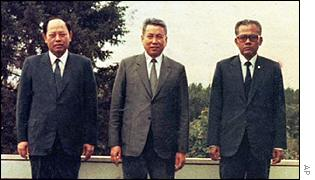
Shortened version of 1984 movie in French https://www.youtube.com/watch?v=PSOQ2M9Ax_M Haing S. Ngor Winning Oscar for Best Supporting Actor 1985 https://www.youtube.com/watch?v=p9FgzH4xizU https://www.youtube.com/watch?v=fBHP--a1m4A
The Killing Fields
Year Zero
The Silent Death of Cambodia
A report by John Pilger
Australian TV (1979)
Cambodia - Year One
A second report by John Pilger
Austalian TV (1980)
From the
Killing Fields
Episode from the documentary series Peter Jennings Reporting (1988)
Cambodia
- Year Ten
A report by John Pilger (1989)
Cambodia - Year Ten (Update)
A report by John Pilger (1989)
Site 2
Documentary film by Rithy Panh (1989) about the largest Cambodian
refugee camp on the Thai border
Sihanouk headed a coalition of three armed resistance forces opposed to the Vietnamese occupation of Cambodia and the puppet Cambodian
government:
- KPNLF (Buddhists/Lon Nol/Son San)
- FUNCIPEC (Royalists) and
- Khmer Rouge (ousted/exiled Cambodian government)
All resistance forces were based on the Thai border.
Cambodia
- The Betrayal
A report by John Pilger (1990)
Son Sen https://www.youtube.com/watch?v=uKFxxCkbRmY Pol Pot was arrested by another Khmer Rouge leader and old comrade, Ta Mok. Pol Pot was to be tried for murder of Son Sen. A few Thai and western journalists were invited to attend the trial, in Anlong Vieng, a
Khmer Rouge border redoubt, This was a rare opportunity offered to the press to see Pol Pot, who had not been seen in public
for 18 years. https://www.youtube.com/watch?v=ktaOAye63A0 Stalin, Hitler,
Mao and Pol Pot? https://www.youtube.com/watch?v=Bk_ezm5gVnc Some in the press had hoped that Pol Pot would be held
to account for the deaths of two million Cambodians during the rule of the Khmer Rouge in Cambodia from 1975 to 1979.
Thus, several months after the show trial, in October 1997,
a western journalist and a western photographer were invited back to Anlong Veng to interview Pol Pot. Khmer translators
were present. Pol Pot recalled that the revolution had not worked out
as hoped and denied responsibility for the deaths of many Cambodians during the Khmer Rouge leadership of the country
from 1975 to 1979. The killing was the work of lower cadres. https://www.youtube.com/watch?v=CQ9_BMshyiw Les
Khmer Rouges Documentaire Le Mystère Pol Pot Documentaire The Khmer Rouge
Tribunal Explained in 7 minutes
https://www.youtube.com/watch?v=b99IkHqt6aQ Looking back
at the Khmer Rouge revolution Australian TV (2010) https://www.youtube.com/watch?v=b0OpOMtOYl8 Bust of Pol Pot made
by prisoners of Tuol Sleng in Phnom Penh Tuol Sleng Prison Documentary
Add documentary
link here Kaing Guek Eav
(alias Duch) In charge of Tuol
Sleng Prison during Khmer Rouge rule of Cambodia The Crimes of
Comrade Duch Australian TV (ca. 2007) Among the many thousands of Cambodians killed
in Tuol Sleng were two Australian yachtsmen https://www.youtube.com/watch?v=AqmbErWjdrs Former Khmer
Rouge chief under spotlight Australian TV (2009) https://www.youtube.com/watch?v=enU9dOIS_Rk Irish photographer
recalls 'finding' Khmer Rouge torturer AFP https://www.youtube.com/watch?v=KprXy7yywVE Khmer Rouge Tribunal
verdict 26 July 2010
https://www.youtube.com/watch?v=sbb-JXA8wCc Cambodia: Khmer
Rouge prison chief 'Duch' found guilty France 24 https://www.youtube.com/watch?v=ElVuKqdRSRA ------------------------ Four Khmer
Rouge Leaders Charged with Genocide https://www.youtube.com/watch?v=mAlUMWKvz-Y ----------------- Ieng Sary Brief Biography https://www.youtube.com/watch?v=I4b7tWoVVDI Case 002: Ieng Sary 13 Dec 2011
https://www.youtube.com/watch?v=-P_7oZ5b64k Khmer Rouge Co-Founder
Dies Before Trial Concludes News https://www.youtube.com/watch?v=ziTKk1njl8U -------------- Nuon Chea Nuon Chea # 2 leader of the Khmers
Rouges Journeyman Pictures (28:20) https://www.youtube.com/watch?v=hO0cnRV9Ouo Enemies of
the People Advertisement for
2010 documentary film https://www.youtube.com/watch?v=dZRkoUTP_Cs --------------------- Khieu Sampan KHMER ROUGE
LEADER KHIEU SAMPHAN FACES TRIAL https://www.youtube.com/watch?v=UaLwMfrjl0A Khieu
Samphan prefers silence 9
July 2013 https://www.youtube.com/watch?v=xM0ZBDhavUk ------------------- Cambodian
Tribunal Convicts Khmer Rouge Leaders Cambodian court finds
Khmer Rouge leaders Nuon Chea, # 2 leader of the Khmer Rouge, and Khieu Sampan, president of Cambodia during Khmer Rouge
rule, guilty of crimes against humanity and sentences them
to life in prison. Associated Press, August 7, 2014 https://www.youtube.com/watch?v=QlQ0aaaNluY Appeal by
Khmer Rouge leaders overruled 23 November 2016 Reuters https://www.youtube.com/watch?v=e2BvRorhtn4 ---------------------- King Norodom Sihamoni
Sihanouk presents
his son Sihamoni In 2004, King Sihanouk abdicated in favor of his
son Sihamoni.
-------------
Pre Vihear Pre
Vihear Pre Vihear is an ancient
Hindu temple built by the Khmers in the A. D. 900s
on a cliff-top in the Dangrek mountains. Pre Vihear is the second-most
sacred temple of the Khmers. The first is Angkor Wat. In the early 1200s, a
powerful Khmer Empire occupied most of the Southeast Asian mainland. As the Mongols pressed down from the north, the Cham,
Viet and Tai battered the Khmers and pushed back the frontiers. The Siamese took the
Khmer capitol Angkor in 1431. The Siamese took Pre
Vihear in 1795. French colonists, arriving
in Indo-China in 1863, took everything back from the
Siamese by the early 1900s. After the defeat of the
French by the Germans in Europe in June 1940, the Thais, with the support of Germany's Axis partner, Japan, took back the northern and western Khmer provinces. Following the Japanese
defeat in August 1945, the French got everything back
in 1946. In 1953, the French granted
Cambodia independence. The Thais then reclaimed
Pre Vihear, which they call Pra Viharn, and Thai soldiers occupied it. The Cambodians appealed
to the United Nation's International Court of Justice
(ICJ) in the Hague in the Netherlands. In 1962, the ICJ awarded
the temple to the Cambodians and the Thais had to leave it. In the early 2000s, the
Thai prime minister, Thaksin Shinawatra, agreed to a Cambodian request for Thailand to relinquish claims
to the promontory on the cliff-top on which the temple stands so Cambodia
could qualifty the temple for UNESCO protection as
a World Heritage site. But In 2008 this plan
was turned into a political issue by Thaksin's opponents to discredit him. He was called a traitor. The Thais renewed
claims that the temple belonged to Thailand. Shooting erupted between
the two sides at several spots along the border. In 2011, the Cambodians
asked the ICJ to clarify its 1962 decision. The ICJ awarded the promontory
to Cambodia on November 11, 2013. Today, both Cambodia and Thailand claim the ancient Khmer
temples of Sdok Kok Thom, Ta Meun Thom and Ta Sawai. The temples are on - or close to
- the disputed border line between the two countries.
In the mid-1990s, the Khmer Rouge controlled several stretches
of the Thai-Cambodian border and retained several thousands of soldiers.
In 1996, Pol Pot and Ieng Sary, the top two leaders of the Khmer Rouge, split.
Video of Ieng
Sary press conferences
Associated Press
and
Khmer Rouge loyal to Ieng Sary flee to Thailand
Following Ieng Sary's break with Pol Pot, the two sides fought
Associated Press
Some Khmer Rouge leaders defected to the Cambodian government.
KHMER ROUGE GUERRILLAS DEFECTING TO GOVERNMENT
Associated Press
--------------------------
In 1997, Hun Sen led a coup d'état, ousting the prime minister, Ranariddh, and
forcing him to flee the country.
Hun Sen has remained Cambodia's ruling prime minister and the country's
strong man to this day.
----------------------------------
Hun Sen sought to persuade Khmer Rouge leaders on the border to leave
the jungle and join ranks.
Pol Pot's right-hand man, Son Sen, entered into negotiations
with Hun Sen.
To stem further defections and factionalism, Pol Pot ordered
the death of his old comrade, Son Sen.
A short
show trial was conducted in Anlong Veng before local villagers in July 1997.
Pol Pot,
in frail health, was criticized and placed under "house arrest" "for life" and left in the care of Ta Mok.
The Trial of Pol Pot
Ted Koppel, ABC News Nightline (1998)
The press made much about Pol Pot’s appearance before the press for the first time in many years.
The trial
was intended by other Khmer Rouge leaders to show to the press and the public that Pol Pot and his followers were no longer
in power. They had been purged.
Pol Pot
Secret Killer
Episode from the documentary series Biography
(1998)
or
Brief excerpts from the interview, uploaded by a
blogger (07:14):
Pol Pot died in 1998
Pouvoir et Terreur
ou
ou



 ------------------------------
------------------------------
THE LAST KING OF LAOS The Last King of Laos ----------- Tom Dooley ---------------
Kong Le (1934 - 2014), army captain, led neutralists
Kong Le on the cover of Time Magazine
Short biographical account https://www.youtube.com/watch?v=KZy6pny7uU8 Kong Le's Coup
d'Etat August 1960 Kong Le Silent film footage https://www.youtube.com/watch?v=Ec9MIKeCmXk Silent film footage https://www.youtube.com/watch?v=R0nh7HRiyow The Counter-Coup by Phoumi Nosavan Retakes Vientiane December 1960 https://www.youtube.com/watch?v=vH2e2jsvh8U Kong Le's neutralist army and the Pathet Lao unite to fight the Royal Lao government --------------- Soviets and PR China flew arms and other supplies to the Viet-Minh
and Pathet Lao in northern Laos. The country was on the verge of a big civil war. Prince Souphanouvong ("The Red Prince") (1909 - 1995), head of
the Communist Pathet Lao. Khamtai
Siphandon, leader of the Pahet Lao military -------------- Prince Souvanna Phouma (1901 - 1984), leader of the government/royalists/neutralists Press conference, Paris 1966 https://www.youtube.com/watch?v=fLGPAznty9s and https://www.youtube.com/watch?v=BX-Ctx_X2Oo ----------------
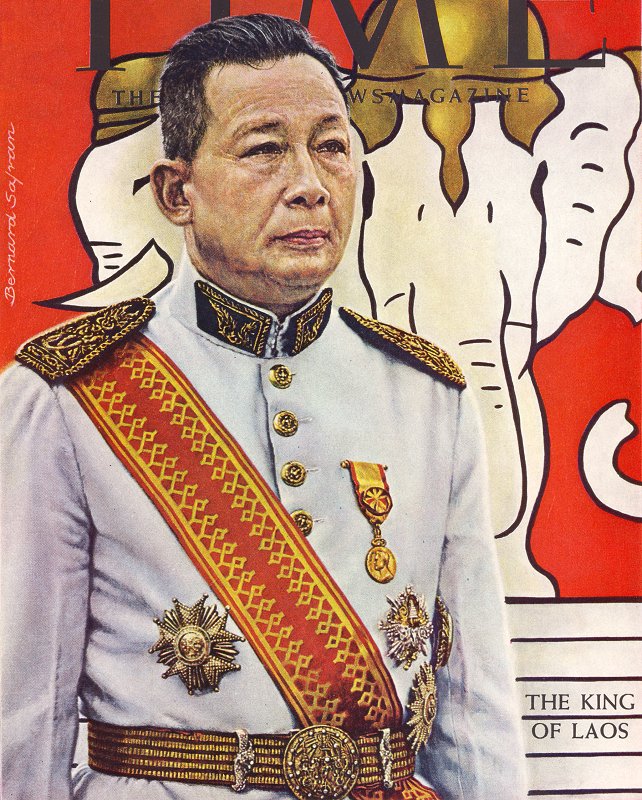
King Savang Vatthana (1907 - 1978/1980/1984), King of Laos (1949 - 1975)
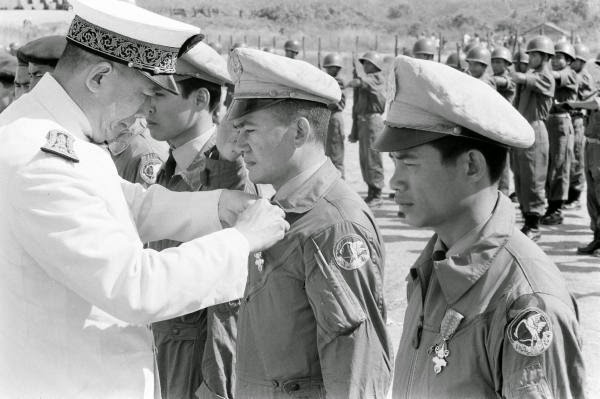
1. https://www.youtube.com/watch?v=UkYTTN9j90U
2. https://www.youtube.com/watch?v=lDCU2s4HjL4
https://www.youtube.com/watch?v=JL6SX6Q5Lr0
The Lao Hmong and the
French Foreign Legion
1954
Includes footage of Hmong leader Touby Lyfoung
https://www.youtube.com/watch?v=5plthlfg6fw
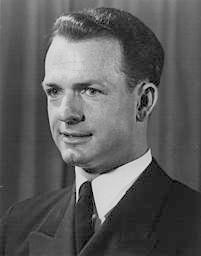
Thomas Dooley
(1927 - 1961), an Americcan
medical doctor
in Laos from 1954 to 1959.
Dr. Tom Dooley
Muang Sing, Laos
or the same in four clips:
--------------------
 Civil Air Transport (CAT)
Civil Air Transport (CAT)
 Laos 1959
Air America
The C. I. A.'s Secret Airline
Episode from the documentary series History Undercover (2000)
-------------
Pop Buell
Edgar ("Pop") Buell (Indiana 1913 - Philippines 1980). Buell was
in Laos from 1960 to 1974. Buell went
to Laos with the private International Voluntary Services Inc. (IVS) to develope agriculture
among the Hmong. Buell eventually managed humanitarian relief to the Hmong for the U.S. Agency for International Development
(USAID). He left Laos in 1974 and lived in Bangkok until his death in 1980.
Edgar "Pop" Buell with the Hmong in Laos
Pop Buell
Hoosier at the Front
Episode from documentary series The Twentieth Century with
Walter Cronkite (1965)
Slide show
----------------
Laos 1959
Air America
The C. I. A.'s Secret Airline
Episode from the documentary series History Undercover (2000)
-------------
Pop Buell
Edgar ("Pop") Buell (Indiana 1913 - Philippines 1980). Buell was
in Laos from 1960 to 1974. Buell went
to Laos with the private International Voluntary Services Inc. (IVS) to develope agriculture
among the Hmong. Buell eventually managed humanitarian relief to the Hmong for the U.S. Agency for International Development
(USAID). He left Laos in 1974 and lived in Bangkok until his death in 1980.
Edgar "Pop" Buell with the Hmong in Laos
Pop Buell
Hoosier at the Front
Episode from documentary series The Twentieth Century with
Walter Cronkite (1965)
Slide show
----------------
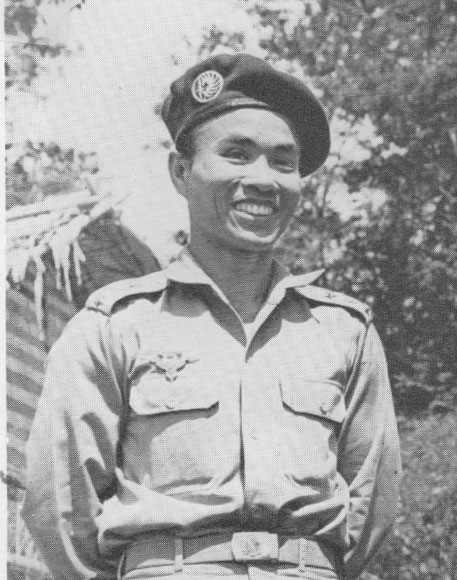
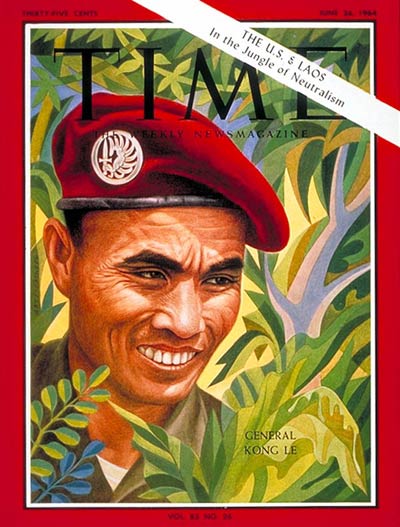
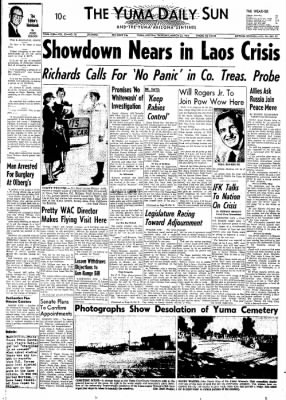 The Yuma Daily Sun, March 23, 1961
Laos Crisis
World Peace Threatened
Universal-International News
Threat to Peace
World Watches Crisis in Laos
Universal-International News
The Yuma Daily Sun, March 23, 1961
Laos Crisis
World Peace Threatened
Universal-International News
Threat to Peace
World Watches Crisis in Laos
Universal-International News
 President Kennedy speaks about the crisis in Laos at a press
confernece in Washington, D. C., on March 23, 1961. The dark areas on the map indicate the most recent phase of growing Communist
influence or control in northern Laos.
President Kennedy's 8th Press Conference
March 23, 1961
Excerpts
Entire press conference
Laos Crisis
Kennedy-Gromyko
Voice Peace Hopes
Universal-International News
Soviet Foreign Minister Andrei Gromyko meets
President Kennedy in White House
March 27, 1961
The Laos Crisis
British Movietone
International
Conference on the Settlement of the Laotian Question
Geneva
May 16, 1961 - July 23, 1962
International
Agreement on the Neutrality of Laos
July 9 and 23, 1962
Agreement among Burma, Cambodia, Canada, France, India, Laos,
North Vietnam, Poland, PR China, South Vietnam, Thailand, UK, USA and USSR.
- All to respect Laotian neutrality
- None to interfere in Laotian internal affairs
- None to enter into a military alliance with Laos
- None to establish military bases in Laos
The Laotians formed a coalition government with three factions
Phoumi Nosavan, pro-American
Prince Souphanouvong,
pro-Communist
Prince Souvanna Phouma, neutralist
Laos
Peace at Last?
Eyes of the World on Laos
after
Coalition Pact
News of the Day
Peace in Laos
Factions Form New Alliance
Universal-International News
Laos
The Country with Three Heads
Movietone News
President Kennedy speaks about the crisis in Laos at a press
confernece in Washington, D. C., on March 23, 1961. The dark areas on the map indicate the most recent phase of growing Communist
influence or control in northern Laos.
President Kennedy's 8th Press Conference
March 23, 1961
Excerpts
Entire press conference
Laos Crisis
Kennedy-Gromyko
Voice Peace Hopes
Universal-International News
Soviet Foreign Minister Andrei Gromyko meets
President Kennedy in White House
March 27, 1961
The Laos Crisis
British Movietone
International
Conference on the Settlement of the Laotian Question
Geneva
May 16, 1961 - July 23, 1962
International
Agreement on the Neutrality of Laos
July 9 and 23, 1962
Agreement among Burma, Cambodia, Canada, France, India, Laos,
North Vietnam, Poland, PR China, South Vietnam, Thailand, UK, USA and USSR.
- All to respect Laotian neutrality
- None to interfere in Laotian internal affairs
- None to enter into a military alliance with Laos
- None to establish military bases in Laos
The Laotians formed a coalition government with three factions
Phoumi Nosavan, pro-American
Prince Souphanouvong,
pro-Communist
Prince Souvanna Phouma, neutralist
Laos
Peace at Last?
Eyes of the World on Laos
after
Coalition Pact
News of the Day
Peace in Laos
Factions Form New Alliance
Universal-International News
Laos
The Country with Three Heads
Movietone News

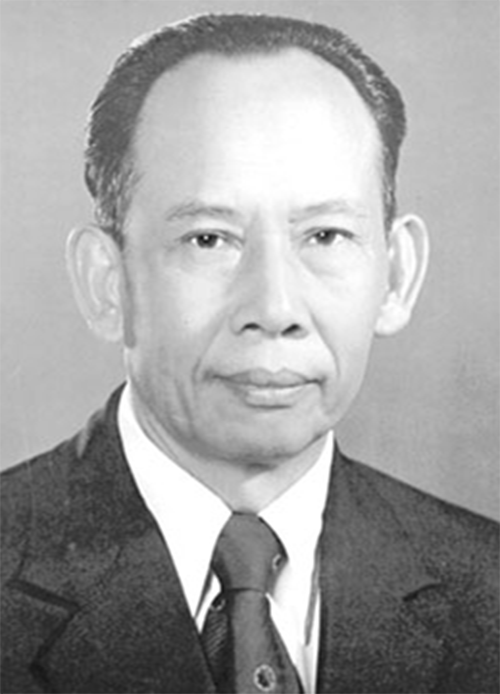
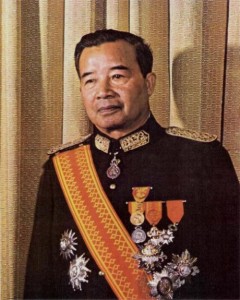
Henry Kissinger
Interview by Stanley Karnow
WGBH-TV Boston
1982
---------------------
The Korean and Vietnam Wars
Victor Davis Hanson
----------------
Apocalypse Now
The most popular Vietnam War flic

MIA MISSING IN ACTION
-------------------------
Missing Soldier Found in Vietnam 44 Years Later
Newsy
Maybe Not
Prisoners of War Betrayed
2007 documentary (50 min.)
or
 The Wall - The Vietnam Veterans Memorial
on the Mall in Washington D. C.
The Wall - The Vietnam Veterans Memorial
on the Mall in Washington D. C.
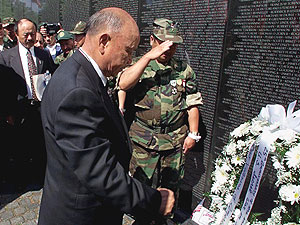
General Vang Pao, Vietnam Veterans Memorial,
Washington, D. C., in 2000
-------------------------
Vietnam and Algeria
Lecture # 21 of the course France Since 1871 by John Merriman
at Yale University in the fall semester of 2007
1. Decolonization after the Second World War (1945 - )
2. Vietnamese
independence: Ho Chi Minh and the Vietminh (1945 - )3. The Algerian Case: The Colons versus the Front de Libération
Nationale
4. The fight for North Africa: Rise of right-wing military control
5. De Gaulle's return to power (1958):
Betrayal of the army, the exit from Algeria (1962)
You Tube:
Yale U.:
Transcript:
Algerie L'autre 8 mai 1945 2014 1. Les chemins de la rébellion La naisance du FLN . . . (55:10) https://www.youtube.com/watch?v=825BLqk5Izo 2. Un Problème de Conscience (54:50) https://www.youtube.com/watch?v=SDP8Sr3m0s8 3. “Je vous ai compris!” De Gaulle (57:34) https://www.youtube.com/watch?v=O4YyX4Vc99s 4. “Aux Barricades!” Le coup d'état des généraux en 1961
(50:07) https://www.youtube.com/watch?v=UtzRxygI5jM L'exode (46:48) https://www.youtube.com/watch?v=bUip8_MUElE ou
Documentaire (1984) Parties 1, 2 et 3 1954 - 1959 La
naisance du FLN . . . (02:50:27) https://www.youtube.com/watch?v=39GVxJF5lrw Parties 4 et 5 Charles De Gaulle and the
Six-Year Algerian War https://www.youtube.com/watch?v=s_Fb2Wjwfl4 (53:09) https://www.youtube.com/watch?v=RynSdGgQGu4 In a referendum on 8 January 1961 the electorate in France and Algeria approved
Algerian self-determination. L'O. A. S. Organisation Armée Secrète January 1961 - 1965 De Gaulle et l'OAS Documentaire (1990) https://www.youtube.com/watch?v=qQksKwCy8SA L'OAS raconte l'OAS Documentaire (2011) https://www.youtube.com/watch?v=Sl68ype60Ls Le Putsch des Généraux Le
Putsch d’Alger 21 avril 1961 Au cœur de l’histoire
sur Europe 1 Les quatre généraux Maurice Challe, Edmond Jouhaud, Raoul Salan et André Zeller
https://www.youtube.com/watch?v=ynbFNAiacAI ALLOCUTION DU GENERAL DE GAULLE Le Putsch des Généraux en 1961 https://www.youtube.com/watch?v=Nn3_5m5vALg De Gaulle et l'Algérie 2000 ans d'histoire https://www.youtube.com/watch?v=rD6xBkrs9rw 1er partie https://www.youtube.com/watch?v=LmzrO3_lj2s 2em partie https://www.youtube.com/watch?v=Sqiuv-GXXGE Algérie Les Deux Soldats L’histoire vraie de deux jeunes Français militaires
https://www.youtube.com/watch?v=apxD9Rrbi7A The French electorate votes for Algerian
independence on 8 April 1962. The Algerian electorate votes for independence on 1 July
1962.
Les Harkis HARKIS LES
SACRIFIÉS PAR BERNARD COLL ET TAOUÈS TITRAOUI https://www.youtube.com/watch?v=f3yU2XWILtU Les Harkis
Trois épisodes de la serie L'Histoire Oubliée 1
(4). L'enrôlement
https://www.youtube.com/watch?v=Zz8VaI3NZ7A 2 (5).
L'abandon https://www.youtube.com/watch?v=Uhq1NrYG-fk 3 (6). Les fils de l'oubli
https://www.youtube.com/watch?v=UCMQPk1uVD0 Histoire
d'un abandon Documentaire https://www.youtube.com/watch?v=ChLeiJ0PW3w La Tragedie des Harkis
Documentaire (2:16:02) https://www.youtube.com/watch?v=UE49HAfvMUU
-------- The Algerian National Assembly proclaims the People's Democratic
Republic of Algeria on September 25, 1962 Ben
Bella coup d'etat 1965 Houari
Boumediene ------------ Algérie
10 ans après L' Algérie des Algériens 1972
Partie1 https://www.youtube.com/watch?v=wpTM5APHCGY
2° partie L'Algérie des français https://www.youtube.com/watch?v=upIYGg-4KZw
3° partie L'Algérie d'aujourd'hui
https://www.youtube.com/watch?v=NXeaqk12qKs
-------------- Alger La Mecque des révolutionnaires
1962 - 1974 Documentaire ARTE (2017) https://www.youtube.com/watch?v=pl-kqS1AHmQ
Algerie
or, with English sub-titles:
----------------
Les massacres répressifs à Sétif en 8 mai 1945
Témoignages sur les massacres 8 mai 45
Documentaire (2014)
----------------
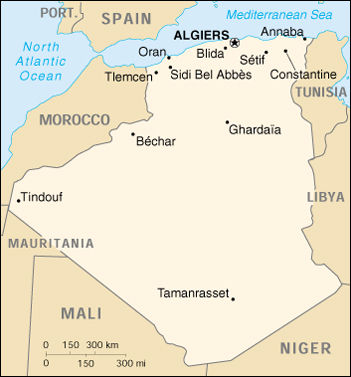 Algerie (1954 - 1962)
Le coup d'état des généraux, l'OAS, l'exode . .
(1:33:09)
1960 American documentary
or
De
Gaulle
Le
retour
13
mai 1958
Documentaire
(1998)
Les Brulures de l’Histoire
VEC
Jacques Chaban-Delmas, Léon Delbecque, Lucien Neuwirth . . .
(52:51)
Je vous
ai compris!
De
Gaulle 1958 - 1962
Docu-fiction
de Serge Moati en 2010
(1:33:34)
Le dernier bal de la 4e république
De
Gaulle et l'Algérie
Le
prix du pouvoir
Documentaire (2010)
Algérie entre 1958 et 1962
Filmer la guerre d'Algerie
Documentaire
Algerie (1954 - 1962)
Le coup d'état des généraux, l'OAS, l'exode . .
(1:33:09)
1960 American documentary
or
De
Gaulle
Le
retour
13
mai 1958
Documentaire
(1998)
Les Brulures de l’Histoire
VEC
Jacques Chaban-Delmas, Léon Delbecque, Lucien Neuwirth . . .
(52:51)
Je vous
ai compris!
De
Gaulle 1958 - 1962
Docu-fiction
de Serge Moati en 2010
(1:33:34)
Le dernier bal de la 4e république
De
Gaulle et l'Algérie
Le
prix du pouvoir
Documentaire (2010)
Algérie entre 1958 et 1962
Filmer la guerre d'Algerie
Documentaire
Les Goumiers Marocains
No. 3 d-une serie L'Histoire Oubliee https://www.youtube.com/watch?v=VglqQ3d7pmg D'un pays à l'autre, les anciens combattants marocains https://www.youtube.com/watch?v=UAHAh5ndu5s Indigènes 2006 2:03:37 https://www.youtube.com/watch?v=ayXzjDb3hV8 ou https://www.youtube.com/watch?v=P45TTGT2XhY&list=PL5mR0PxdNDZ7rlAic_Y5r-4O7LqOqinVn
Le Maroc
Soldat marocain de la Seconde Guerre mondiale